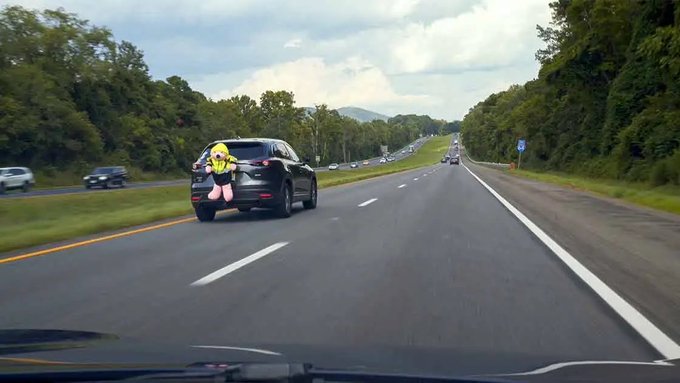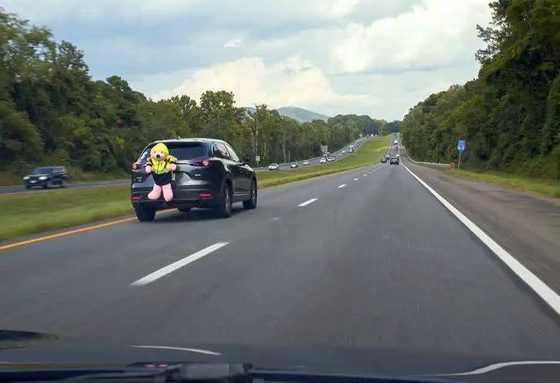

News
Level 2 systems like Tesla Autopilot can improve drivers’ attentiveness: IIHS study
The Insurance Institute for Highway Safety (IIHS) recently published the results of a rather unique real-world driver attentiveness test. Using a 2019 Mercedes-Benz C300 equipped with a Level 2 Advanced Driver Assistance System (ADAS) and a giant pink teddy bear dressed in a yellow high-visibility jacket, the agency was able to roughly determine if systems like GM’s Super Cruise and Tesla’s Autopilot make drivers less attentive on the road.
The participants of the study included both drivers who were familiar with Level 2 driver-assist systems and drivers who had little to no experience with ADAS. The IIHS tasked those familiar with Level 2 systems to drive with the Mercedes-Benz C300’s ADAS activated. A group of drivers unfamiliar with ADAS was also tasked to drive with the system engaged. Lastly, a group of drivers who were unfamiliar with the vehicle’s Level 2 system was tasked to drive without the advanced driver-assist feature activated.
To test the drivers’ situational awareness, the IIHS had an SUV with a giant pink teddy bear strapped to its back pass the Mercedes-Benz C300 three times as the participants drove over a stretch of Interstate 70 in Maryland for about an hour. Each time, the SUV with the massive stuffed bear stayed in front of the drivers for about 30 seconds. Researchers then measured the participants’ reactions after their driving session, while asking if they saw anything odd during their hour-long drive.
Interestingly enough, nearly all of the drivers who were experienced with Level 2 systems noticed the giant pink bear. The same group also identified the number of times the bear overtook the C300 during the hour-long test. Drivers who were inexperienced with Level 2 systems didn’t perform as well, with a good number of inexperienced drivers who used the C300’s ADAS failing to remember the giant pink teddy bear at all.
“Our data suggest that Level 2 driving automation has the potential to improve a driver’s situational awareness (SA) once he or she is familiar with the technology, although it does not guarantee it. Unfamiliar drivers, however, appear to have even more difficulty maintaining SA when using the system than when driving without it. On average, participants who were familiar with Level 2 systems showed the highest degree of SA about the bear when using the system, unfamiliar participants who drove with the system off had moderate SA, and unfamiliar participants who drove with the system on demonstrated the lowest SA,” the IIHS wrote.
Videos from inside the C300 showed that the drivers who correctly identified the giant stuffed bear actually spent more time scanning the road ahead of them. These drivers, particularly those familiar with Level 2 systems, even tended to look out of the car’s side windows. On the other hand, those who missed the bear spent a considerable amount of time just focusing on the road straight ahead. Drivers who failed to spot the bear even once spent considerable time looking at various aspects of the C300’s dash.
Considering the results of the IIHS’ study, it appears that some experience with Level 2 systems would be best for drivers before they are allowed access to more advanced driver-assist systems such as Tesla’s Full Self-Driving Beta, which is poised to be rolled out to a greater number of electric car owners in a couple of weeks. Situational awareness, after all, is critical when driving, and having drivers nervously fiddling around their vehicles’ features while operating a Level 2 system may present some risks. That being said, the IIHS’ results do go in line with one of Elon Musk’s more notable points–systems like Autopilot could actually perform as a formidable safety feature, provided that they are used responsibly and properly, of course.
The IIHS’ situational awareness study could be accessed below.
IIHS Level 2 Autonomy Report by Simon Alvarez on Scribd
Don’t hesitate to contact us for news tips. Just send a message to tips@teslarati.com to give us a heads up.

Elon Musk
Elon Musk and Tesla AI Director share insights after empty driver seat Robotaxi rides
The executives’ unoccupied tests hint at the rapid progress of Tesla’s unsupervised Robotaxi efforts.

Tesla CEO Elon Musk and AI Director Ashok Elluswamy celebrated Christmas Eve by sharing personal experiences with Robotaxi vehicles that had no safety monitor or occupant in the driver’s seat. Musk described the system’s “perfect driving” around Austin, while Elluswamy posted video from the back seat, calling it “an amazing experience.”
The executives’ unoccupied tests hint at the rapid progress of Tesla’s unsupervised Robotaxi efforts.
Elon and Ashok’s firsthand Robotaxi insights
Prior to Musk and the Tesla AI Director’s posts, sightings of unmanned Teslas navigating public roads were widely shared on social media. One such vehicle was spotted in Austin, Texas, which Elon Musk acknowleged by stating that “Testing is underway with no occupants in the car.”
Based on his Christmas Eve post, Musk seemed to have tested an unmanned Tesla himself. “A Tesla with no safety monitor in the car and me sitting in the passenger seat took me all around Austin on Sunday with perfect driving,” Musk wrote in his post.
Elluswamy responded with a 2-minute video showing himself in the rear of an unmanned Tesla. The video featured the vehicle’s empty front seats, as well as its smooth handling through real-world traffic. He captioned his video with the words, “It’s an amazing experience!”
Towards Unsupervised operations
During an xAI Hackathon earlier this month, Elon Musk mentioned that Tesla owed be removing Safety Monitors from its Robotaxis in Austin in just three weeks. “Unsupervised is pretty much solved at this point. So there will be Tesla Robotaxis operating in Austin with no one in them. Not even anyone in the passenger seat in about three weeks,” he said. Musk echoed similar estimates at the 2025 Annual Shareholder Meeting and the Q3 2025 earnings call.
Considering the insights that were posted Musk and Elluswamy, it does appear that Tesla is working hard towards operating its Robotaxis with no safety monitors. This is quite impressive considering that the service was launched just earlier this year.
Elon Musk
Starlink passes 9 million active customers just weeks after hitting 8 million
The milestone highlights the accelerating growth of Starlink, which has now been adding over 20,000 new users per day.

SpaceX’s Starlink satellite internet service has continued its rapid global expansion, surpassing 9 million active customers just weeks after crossing the 8 million mark.
The milestone highlights the accelerating growth of Starlink, which has now been adding over 20,000 new users per day.
9 million customers
In a post on X, SpaceX stated that Starlink now serves over 9 million active users across 155 countries, territories, and markets. The company reached 8 million customers in early November, meaning it added roughly 1 million subscribers in under seven weeks, or about 21,275 new users on average per day.
“Starlink is connecting more than 9M active customers with high-speed internet across 155 countries, territories, and many other markets,” Starlink wrote in a post on its official X account. SpaceX President Gwynne Shotwell also celebrated the milestone on X. “A huge thank you to all of our customers and congrats to the Starlink team for such an incredible product,” she wrote.
That growth rate reflects both rising demand for broadband in underserved regions and Starlink’s expanding satellite constellation, which now includes more than 9,000 low-Earth-orbit satellites designed to deliver high-speed, low-latency internet worldwide.
Starlink’s momentum
Starlink’s momentum has been building up. SpaceX reported 4.6 million Starlink customers in December 2024, followed by 7 million by August 2025, and 8 million customers in November. Independent data also suggests Starlink usage is rising sharply, with Cloudflare reporting that global web traffic from Starlink users more than doubled in 2025, as noted in an Insider report.
Starlink’s momentum is increasingly tied to SpaceX’s broader financial outlook. Elon Musk has said the satellite network is “by far” the company’s largest revenue driver, and reports suggest SpaceX may be positioning itself for an initial public offering as soon as next year, with valuations estimated as high as $1.5 trillion. Musk has also suggested in the past that Starlink could have its own IPO in the future.
News
NVIDIA Director of Robotics: Tesla FSD v14 is the first AI to pass the “Physical Turing Test”
After testing FSD v14, Fan stated that his experience with FSD felt magical at first, but it soon started to feel like a routine.

NVIDIA Director of Robotics Jim Fan has praised Tesla’s Full Self-Driving (Supervised) v14 as the first AI to pass what he described as a “Physical Turing Test.”
After testing FSD v14, Fan stated that his experience with FSD felt magical at first, but it soon started to feel like a routine. And just like smartphones today, removing it now would “actively hurt.”
Jim Fan’s hands-on FSD v14 impressions
Fan, a leading researcher in embodied AI who is currently solving Physical AI at NVIDIA and spearheading the company’s Project GR00T initiative, noted that he actually was late to the Tesla game. He was, however, one of the first to try out FSD v14.
“I was very late to own a Tesla but among the earliest to try out FSD v14. It’s perhaps the first time I experience an AI that passes the Physical Turing Test: after a long day at work, you press a button, lay back, and couldn’t tell if a neural net or a human drove you home,” Fan wrote in a post on X.
Fan added: “Despite knowing exactly how robot learning works, I still find it magical watching the steering wheel turn by itself. First it feels surreal, next it becomes routine. Then, like the smartphone, taking it away actively hurts. This is how humanity gets rewired and glued to god-like technologies.”
The Physical Turing Test
The original Turing Test was conceived by Alan Turing in 1950, and it was aimed at determining if a machine could exhibit behavior that is equivalent to or indistinguishable from a human. By focusing on text-based conversations, the original Turing Test set a high bar for natural language processing and machine learning.
This test has been passed by today’s large language models. However, the capability to converse in a humanlike manner is a completely different challenge from performing real-world problem-solving or physical interactions. Thus, Fan introduced the Physical Turing Test, which challenges AI systems to demonstrate intelligence through physical actions.
Based on Fan’s comments, Tesla has demonstrated these intelligent physical actions with FSD v14. Elon Musk agreed with the NVIDIA executive, stating in a post on X that with FSD v14, “you can sense the sentience maturing.” Musk also praised Tesla AI, calling it the best “real-world AI” today.








